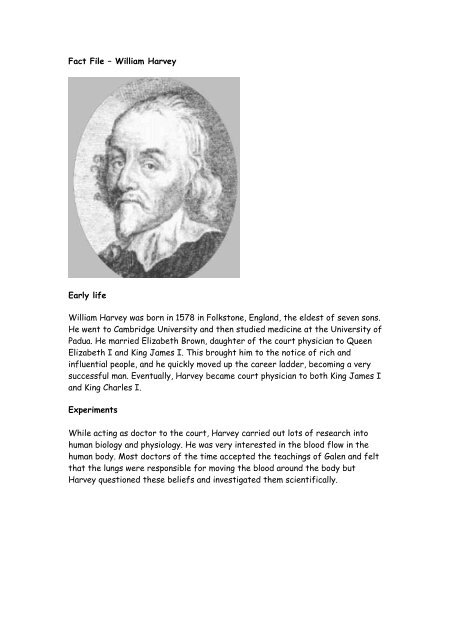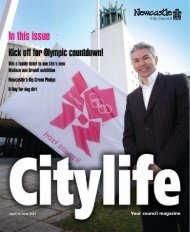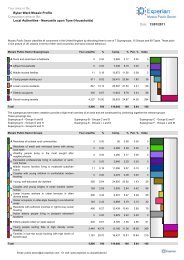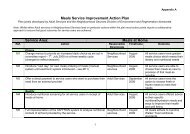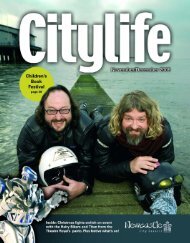Fact File – William Harvey Early life William Harvey was born in ...
Fact File – William Harvey Early life William Harvey was born in ...
Fact File – William Harvey Early life William Harvey was born in ...
Create successful ePaper yourself
Turn your PDF publications into a flip-book with our unique Google optimized e-Paper software.
<strong>Fact</strong> <strong>File</strong> <strong>–</strong> <strong>William</strong> <strong>Harvey</strong><br />
<strong>Early</strong> <strong>life</strong><br />
<strong>William</strong> <strong>Harvey</strong> <strong>was</strong> <strong>born</strong> <strong>in</strong> 1578 <strong>in</strong> Folkstone, England, the eldest of seven sons.<br />
He went to Cambridge University and then studied medic<strong>in</strong>e at the University of<br />
Padua. He married Elizabeth Brown, daughter of the court physician to Queen<br />
Elizabeth I and K<strong>in</strong>g James I. This brought him to the notice of rich and<br />
<strong>in</strong>fluential people, and he quickly moved up the career ladder, becom<strong>in</strong>g a very<br />
successful man. Eventually, <strong>Harvey</strong> became court physician to both K<strong>in</strong>g James I<br />
and K<strong>in</strong>g Charles I.<br />
Experiments<br />
While act<strong>in</strong>g as doctor to the court, <strong>Harvey</strong> carried out lots of research <strong>in</strong>to<br />
human biology and physiology. He <strong>was</strong> very <strong>in</strong>terested <strong>in</strong> the blood flow <strong>in</strong> the<br />
human body. Most doctors of the time accepted the teach<strong>in</strong>gs of Galen and felt<br />
that the lungs were responsible for mov<strong>in</strong>g the blood around the body but<br />
<strong>Harvey</strong> questioned these beliefs and <strong>in</strong>vestigated them scientifically.
An illustration from <strong>Harvey</strong>'s book published <strong>in</strong> 1628.<br />
<strong>Harvey</strong> carried out many experiments, both dissections and physiological<br />
experiments on animals. His observations of dissected hearts showed that the<br />
valves <strong>in</strong> the heart allowed blood to flow <strong>in</strong> only one direction. Direct observation<br />
of the heartbeat of liv<strong>in</strong>g animals showed that the ventricles contracted<br />
together, dispell<strong>in</strong>g Galen's theory that blood <strong>was</strong> forced from one ventricle to<br />
the other. Dissection of the septum of the heart showed that it conta<strong>in</strong>ed no<br />
gaps or perforations. When <strong>Harvey</strong> removed the beat<strong>in</strong>g heart from a liv<strong>in</strong>g<br />
animal, it cont<strong>in</strong>ued to beat, thus act<strong>in</strong>g as a pump, not a suck<strong>in</strong>g organ. <strong>Harvey</strong><br />
also used mathematical data to prove that the blood <strong>was</strong> not be<strong>in</strong>g consumed.<br />
Removal of the blood from human cadavers (dead bodies) showed that the heart<br />
could hold roughly two ounces of blood. By calculat<strong>in</strong>g the number of heartbeats<br />
<strong>in</strong> a day and multiply<strong>in</strong>g this by two ounces, he showed that the amount of blood<br />
pumped <strong>was</strong> far greater than the amount that the body could possibly make. He<br />
based this figure on how much food and liquids a person could eat dur<strong>in</strong>g a day.<br />
To <strong>Harvey</strong>, this showed that the teach<strong>in</strong>g by Galen that the blood <strong>was</strong> be<strong>in</strong>g<br />
consumed by the organs of the body <strong>was</strong> false. Blood had to be flow<strong>in</strong>g through a<br />
'closed circuit' <strong>in</strong>stead. Even though he lacked a microscope, <strong>Harvey</strong> theorized<br />
that the arteries and ve<strong>in</strong>s were connected to each other by capillaries, which<br />
would later be discovered by Marcello Malpighi some years after <strong>Harvey</strong>'s<br />
death.<br />
<strong>Harvey</strong> asked simple, po<strong>in</strong>ted questions such as why did both the lungs and the<br />
heart move if only the lungs were responsible for caus<strong>in</strong>g circulation of blood?<br />
Why should, as Galen suggested, structurally similar parts of the heart have<br />
very different functions? Why did 'nutritive' blood appear so similar to 'vital'<br />
blood?
Reaction to <strong>Harvey</strong>’s discovery<br />
<strong>Harvey</strong>'s lecture notes show that he believed <strong>in</strong> the role of the heart <strong>in</strong><br />
circulation of blood through a closed system as early as 1615. Yet he waited 13<br />
years, until 1628, to publish his f<strong>in</strong>d<strong>in</strong>gs. Why did he wait so long? The study and<br />
practice of medic<strong>in</strong>e as orig<strong>in</strong>ally taught by Galen, <strong>was</strong> almost sacred at the time<br />
<strong>Harvey</strong> lived. No one dared to challenge it. To rebel aga<strong>in</strong>st the teach<strong>in</strong>gs of<br />
Galen could quickly end the career of any doctor. Perhaps this is why <strong>Harvey</strong><br />
waited - and if so his fears were proved accurate.<br />
After <strong>Harvey</strong>'s work <strong>was</strong> published, many other doctors and scientists rejected<br />
him and his f<strong>in</strong>d<strong>in</strong>gs. Some of his patients deserted him. Us<strong>in</strong>g different<br />
assumptions of the amount of blood conta<strong>in</strong>ed <strong>in</strong> the heart, scientists argued<br />
that the blood could <strong>in</strong>deed be consumed. Controversy raged for a full twenty<br />
years after publication of <strong>Harvey</strong>'s book. Yet, with time, more and more people<br />
accepted <strong>Harvey</strong>'s ideas.<br />
<strong>Harvey</strong>'s new understand<strong>in</strong>g of the circulation of the blood had very little<br />
effect on the practice of medic<strong>in</strong>e <strong>in</strong> his <strong>life</strong>time, yet it became the foundation<br />
for all modern research on the heart and cardiovascular medic<strong>in</strong>e. It has been<br />
said that <strong>Harvey</strong>'s proof of the cont<strong>in</strong>uous circulation of the blood with<strong>in</strong> a<br />
conta<strong>in</strong>ed system <strong>was</strong> the seventeenth century's most significant achievement <strong>in</strong><br />
physiology and medic<strong>in</strong>e - <strong>in</strong> fact, his work is considered to be one of the most<br />
important contributions <strong>in</strong> the history of medic<strong>in</strong>e.<br />
Source Timel<strong>in</strong>escience resources


